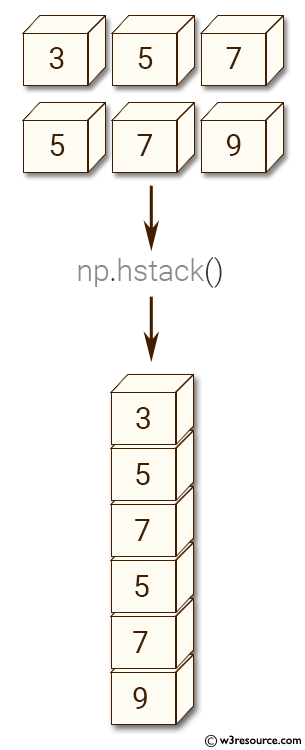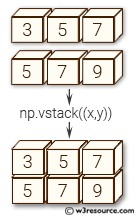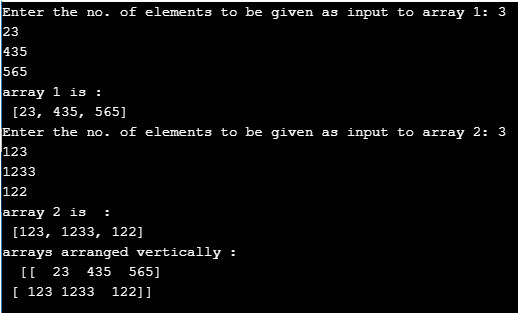
you can grow them using hstack and vstack although I am not sure how. For example, you can sort by the second column, then the third column, then the first column by supplying order=. One big win here over numpy is that theres the push function on Julia. The only advantage to this method is that the "order" argument is a list of the fields to order the search by. [4, 5, really is the most elegant way to do it, as far as I know. Python NumPy hstack() Function Python NumPy broadcast() Function Python numpy.log() Function numpy. Columns: If you use NumPy vstack, the input arrays have to possess exactly the identical amount of columns. Do the Number of Columns and Rows Needs to Be Same Rows: No, if you use NumPy vstack, the input arrays may have a different number of rows. Aside from that however, the syntax and behavior is quite similar. It returns a stacked ndarray i.e, the stacked array of the input arrays. The significant distinction is that np.hstack unites NumPy arrays horizontally and np. Is it a more efficient implementation Otherwise, I cannot find a reason for just having vstack. Reading through the documentation, it looks as if columnstack is an implementation of vstack for 1D arrays. The "correct" way is quite ugly if you didn't initially define your array with fields.Īs a quick example, to sort it and return a copy: Python Numpy vstack() Method with Examples. What exactly is the difference between numpy vstack and columnstack. However, you'll need to view your array as an array with fields (a structured array). How do I concat numpy answer is actually the most elegant way of doing it.įor the "correct" way see the order keyword argument of But the ones I have looked at use the field copy method, so they won't save any time. That module has functions to merge arrays. Won't help as an intermediate array, since it has lost the original column dtypes. If you have a list of sublists, you'll need to convert the sublists to tuples: Syntax: numpy. We can make a horizontal stacking using hstack() method. In : arr=np.zeros((3,),dtype='S10,bool')Īrray(, Scenario 1 : Horizontal Stacking using hstack in numpy. However, A1 and B1 can be of different length, because np.There are 2 (main) ways of adding values to a structured array - with a list of tuples or by copying values to each field. Using the graphic to illustrate, A1 and A2 must have the same length, B1 and B2 must have the same length, because NumPy array requires all the nested arrays to have the same size. Therefore, the length of the elements in the array a and b doesn’t have to be the same, as long as the nested arrays within a or within b have the same length.

Then, np.hstack just repeats the process until running out of the valid elements. In fact, np.hstack stacks input arrays by first concatenate the 1st elements in the input arrays, and making this concatenation as the 1st row in the output array.

Is the result the same as what you expected? Probably not. As we have seen the so many example of vstack (). The vstack () function stacks the sequence of array vertically and hstack () stacks the horizently. numpy.vstack () is defined as: numpy.vstack(tup) Stack arrays in sequence vertically (row wise). a = np.array(, ]) b = np.array(, ]) np.hstack((a,b)) # Result #, # ] Difference between vstack and hstack Both numpy works in the same way with the a difference of axis. When input arrays are not 1-dim, np.hstack concatenates two arrays along the second axis (column).


tup (sequence of ndarrays) The arrays must. When the input arrays are 1-dimensional, np.hstack returns a new 1-dim array containing all the elements in a and b. The functions concatenate, stack and block provide more general stacking and concatenation operations. a = np.array() b = np.array() np.hstack((a,b)) # Result # This is super straight-forward, np.hstack just concatenates two arrays along the first axis (row). There are two functions used for this: hstack() vstack(). We’ll look at 2 situations: the input array is 1-dimensional/multi-dimensional. The only difference between stacking and concatenation is that stacking is done along an axis.


 0 kommentar(er)
0 kommentar(er)
